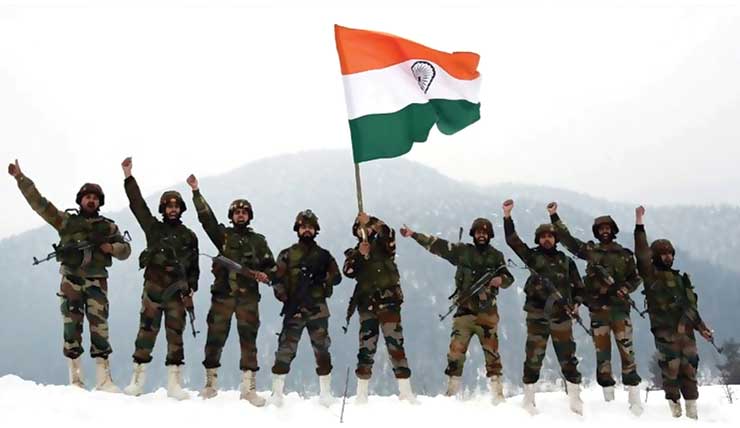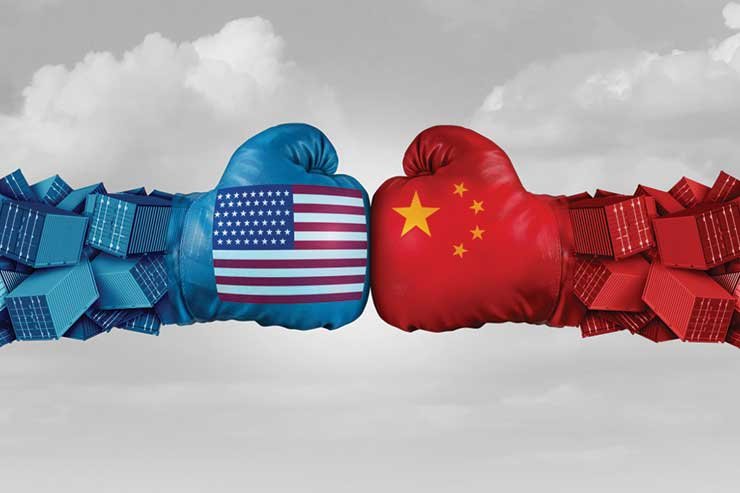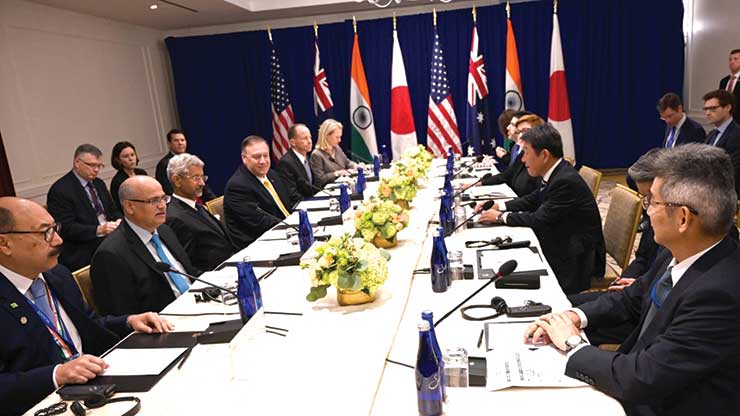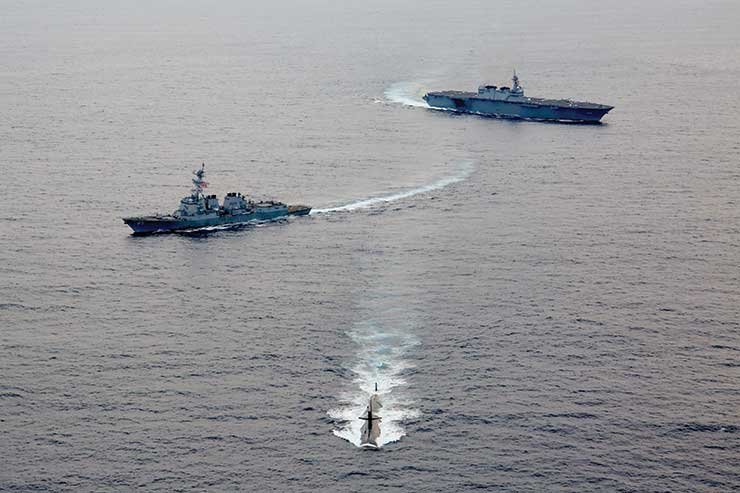
The growing dominance of China and its intimidating stance in the Asian subcontinent has fuelled its expansionist tendencies across its land borders and costal frontiers. Over the years China’s visible coercive and threatening activities along the Sino-Indian Line of Actual Control (LAC) and in the South China Sea (SCS) has led to a partial destruction of the strategic balance in the region. On land, China has moved steadily to take full control over the territory and its restive minority population in Tibet, defend its ground lines of communication to Central Asia via Pakistan through its Belt and Road Initiative (BRI) strategy, and exert increasing pressure on its border with India.
At sea, China has increased its maritime presence and influence from the Senkaku Islands in the East China Sea through Taiwan, South China Sea (SCS), the Indian Ocean to Djibouti and other parts of eastern Africa. From a geo strategic perspective, the confluence of trade, competing territorial claims, and consequent demands for military force is creating a new Indo-Pacific “Ring of Fire” of potential conflict flashpoints principally surrounding India and SCS. The perceived Chinese hegemonistic aim appears to stymie the growth of India as a global power while taking full control over the SCS.
Strategic security situation in South and East Asia India
The ongoing border intransigence with China is vexed with a sense of political and military insecurity borne out of the visible military asymmetry in numbers and technology besides its collusive intent with Pakistan. That notwithstanding, India is today juxtaposed between a global economic and political power in being and a regional nuclearised military power whose war waging potentials transcend these seemingly debilitating military inequalities. While the hard fact of China’s military modernisation and increasingly aggressive foreign policy cannot be wished away, it can be militarily confronted given the current political will and defence preparedness. However for an enduring peace, it is incumbent that India should endeavour to bridge this capability imbalance with military diplomacy as an instrument of state craft. Therefore from a regional strategic security standpoint China shall be the principal adversary as we stretch into the next decade. At the same time there will be a marked escalation in the ongoing terrorist and irregular threats, as well as perceived conventional and nuclear threats from less-formidable regional opponents.
While border provocations, with the potentials for escalation, require a challenging and equally befitting response, it calls for a robust military capability to deal with such incursion besides being prepared to counter any possible escalation. In this regard India today is at the threshold of a credible deterrence against China. However it needs to build on it to reach a level where it can translate into a limited punitive deterrence that is capable of imposing reasonable destructive costs in men and material. The capability should preferably be intrinsic but considering the prohibitive cost and time factor it can be acquired through “military alliance’.
In the Indian context a visible shift in the defensive mindset of the political class is allowing for greater military flexibility in calibrating such responses, made possible by acquisition and development of weapon systems with increased standoff ranges, warhead lethality and precision engagement. Air power, long range artillery, weaponised Unmanned Aerial System (UAS) /drones, maritime dominance and space based deterrence shall be significant contributors. That notwithstanding the focus should be on global military alliances as part of defence diplomacy that shall play a dominant role in checkmating a belligerent adversary. It represents a collective show of force with shared interest against a common enemy and will act as a deterrent besides allowing the flexibility of leveraging military strengths in times of conflict.
Japan
Japan’s regional security threats, stems from China’s relentless attempts to change the status quo of the sea area around the Senkaku Islands by coercion and North Korea’s belligerent behaviour contingent on its nuclear missile programs and the abductions of Japanese citizens. Thus Japanese foreign policy and security perceptions have undergone a perceptible and steady change to include India within its ambit of security alliance. These actions may be viewed as a significant step in India’s growing international politico-security profile to not only act as a regional stabilising factor addressing hard security concerns against China and North Korea but also to dispel Japan’s maritime insecurities that emerge from its quest for assured energy supplies and security of its large maritime interests as a trading nation. Towards this end India‘s bilateral summit has spelt out concrete steps on a range of global and regional security issues including maritime cooperation in the Indo-Pacific region where the influence of China is growing. Revival of Quadrilateral Security Dialogue (QUAD) signals deeper defence cooperation.
Australia
India and Australia, against the backdrop of their frosty relations with China, unveiled a shared vision for maritime cooperation in the Indo-Pacific, as a counter to the growing Chinese military assertiveness. As a sequel to Chinese border incursion with India and strained relations with Australia, after Canberra pitched for an international probe into the origin of the Coronavirus pandemic which is widely believed to have started in China’s Wuhan city, the India-Australia relations touched a new level with both the countries elevating their ties to a “comprehensive strategic partnership”, that includes a reciprocal access to military bases namely the Mutual Logistics Support Agreement (MLSA).

The MLSA will allow militaries of the two countries to use each other’s bases for repair and replenishment of supplies besides facilitating scaling up of overall defence cooperation. India has already signed similar agreements with the US, France and Singapore. The inclusion of Australia in MALABAR, the annual India-Japan-US maritime exercise is reflective of the regional credibility of QUAD which in the limited sense may be classified as an extension of India’s defence diplomacy where joint exercises and capability matching are a part.
Taiwan
China’s aggressive military probing has been going on for years — an unending stress test for the democratic island of Taiwan. But in 2020, the threat has taken on a new intensity wherein Taiwan had to scramble fighters to intercept Chinese warplanes flying towards or even into Taiwan’s airspace. With China, cracking down on freedom fighters in Hong Kong, accused of sweeping repression against the Uyghurs in Xinjiang, expanding in the South China Sea, and clashing with India in the Himalayas, Taiwan seems to be next on the line.
Whereas Taiwan, despite flourishing into a vibrant, high-tech democratic society since its split from mainland China, is yet to be recognised as an independent state and is dwarfed by China’s sheer size and military capability. Crucially, the military gap between China and Taiwan widens every year. Although it is under Washington’s military commitment, these are highly ambiguous. More recently China’s border clashes with India have evoked anti-Beijing sentiments among the Indian public which has led to a growing sense of solidarity with the pro-independence movements in Hong Kong and Taiwan. Close on its heel is the US legislations for the support of Taiwan. However, India’s approach has been one of caution but soon could change if the border intransigence continues.
Vietnam
Vietnam considers the Asia-Pacific region, including Southeast Asia, to be not only its own living space, but also a centre for dynamic development that occupy an increasingly important geo-economic, geo-politic and geo-strategic significance. Most importantly, it recognises the region as a boiling cauldron where great powers compete for influence. China’s Belt and Road Initiative and the US Free and Open Indo-Pacific Strategy among others, are mechanisms for these powers to exert control. From a strategic standpoint Hanoi considers disputes in the South China Sea as one of the most destabilising elements that threaten regional stability. More explicitly than ever in the recent past, Vietnam has endured Chinese assertiveness, including unilateral and power-based coercion, violation of international law, militarisation, change in the status-quo and infringement over its sovereign rights, and jurisdiction.
While it does not call out China by name, it is clear that Vietnam reflects fears of Chinese encroachment and reaffirms its long standing strategy of “four-nos and one-depend.” This means no military alliances, no siding with one country against another, no foreign military bases, and no using force or threatening to use force in international relations; but, “depending on circumstances and specific conditions, Vietnam will consider developing necessary and appropriate defence and military relations with other countries.” It represents the flexibility and resilience long embedded in Vietnam’s foreign policy and significantly expands the spectrum of strategic choices by giving the military more room to manoeuvre. The strategic necessity of dealing with an aggressive China brings India and Vietnam closer together. Vietnam has been emerging as a pivotal state in India’s Act East policy, which can be reflected in multiple dimension of cooperation including defence cooperation.
Cambodia
Although the current marriage of convenience with China yields economic benefits today, this trend could potentially drag Cambodia into Beijing’s geopolitical tutelage and, as a result, threaten its national security interest in the long run, if not properly strategised. Internally, the influx of Chinese immigrants has fuelled criminal activities and alienated local and foreign tourists from other countries. Economically, Cambodia is now one of several countries around the world whose debt to China amounts to more than 25 per cent of its gross domestic product (GDP).

Diplomatically, Cambodia’s reputation on the world stage has suffered a number of setbacks. The military agreement between Cambodia and China in Ream Naval Base is another sign of Phnom Penh’s unhealthy drift to Beijing. If true, this naval outpost will put Cambodia in an uncomfortable position vis-à-vis neighbouring Thailand and Vietnam, who have beefed up their armed forces in recent years besides impacting the existing regional security architecture in Southeast Asia and the Asia-Pacific as a whole. While Indo Cambodian relations are cordial it needs to build its relations with India, to avoid overdependence on China. Cambodia has to invigorate the Indian card to balance China’s economic and geopolitical influence in Cambodia as well as in Southeast Asia.
Singapore
The island nation has maintained its ties with Washington and Beijing without provoking the ire of either side. But as US-China relations deteriorate and tensions grow in the South China Sea, Singapore’s balancing act is proving to be amorphous. However, Singapore’s long-standing relationship with the United States is a classic exposition of the island nation’s foreign policy – taking the world as it is, and seeking to entrench American power and presence in the region for the collective good. Singapore has also sought to involve as many major powers in the regional balance, so that no power can dominate, Singapore and the Association of Southeast Asian Nations (ASEAN). Its position of not “choosing sides” between Beijing and Washington comes as a natural evolution of its balance-of-power approach. Its relation with India also continues on similar lines while maintaining a strong military diplomacy for its security preparedness.
Indonesia
The recent tensions between China and Indonesia in the Natuna islands, has once again put the spotlight on this flashpoint, and is expected to continue with a range of ongoing Indonesian reactions. But importantly it reflects Indonesia’s inability to deter Beijing’s incursion into Jakarta’s waters. While Indonesia technically does not consider itself a claimant in the South China Sea disputes, it is an interested party to safeguard regional stability, and uphold international law, including the United Nations Convention of the Law of the Sea (UNCLOS), as the world’s largest archipelagic state. Indonesia’s traditional approach to the South China Sea can be best summed up as a “delicate equilibrium”, seeking to engage China diplomatically on the issue while at the same time pursuing a range of security, legal, and economic measures designed to protect its own interests.
While Indonesia has taken actions in response to periodic incursions into Indonesian waters, including shoring up military capabilities related to the Natuna islands and launching diplomatic protests, there has been no tangible impact. Instead Chinese incursions have continued episodically. In fact China’s deliberate efforts at cyclical incursions and escalations to test responses have also posed a huge issue for South China Sea claimant states, be it Malaysia, which traditionally prides itself on having a special relationship with Beijing, or Vietnam, which remains the most capable of standing up to China.
Thus with Chinese incursions continuing unabated the South China Sea is heating up to be a global flashpoint. The issue of China’s aggressive posturing in eastern Ladakh and South China Sea figured in the recent ministerial talks between India and Indonesia who have agree to expand defence ties and technology sharing.
United States of America (USA) – The Changing Fundamentals of US-China Relations
Currently, the United States and China are engaged in an intensive and costly trade war that, even if resolved through negotiations, is unlikely to provide the basis for long-term stability. Instead, it may carry the seeds of future confrontation. In fact, bureaucratic processes on both sides are straining to keep up with the growing diversity and complexity of the relationship that is global in scope and consequence. As China emerges as a global power the confrontation seems more belligerent and challenging US interests.
Interestingly, Asia as a continent is increasingly becoming the focus of interest for the United States and the world since it is home to 40 per cent of the world GDP, 65 per cent of global population, and accounts for seven largest militaries with six declared nuclear states. Thus, in the twenty-first century, Asia is the focus of power dynamics, and economic globalisation. Ironically China’s aggressive posturing in Eastern Ladakh and coercive actions in the South China Sea is a destabilising factor that has necessitated global intervention with US bearing the mantle. Thus Asia’s growing economic importance and China being a major power, its behaviour has assumed even greater significance for the United States and the world particularly when US China relations have sharply deteriorated.

Beijing and Washington traded blame over the Coronavirus pandemic, remained locked in a trade war, competed over 5G networks and other technologies, and clashed over rights abuses in Xinjiang, Hong Kong and Taiwan, among other issues. The latest is the contentious issues of US legislations in support of Taiwan and Tibet. The Tibetan Policy and Support Act of 2020 and Taiwan Assurance Act of 2020 include economic sanctions against China for appointing the next Dalai Lama while the other seeks to strengthen Washington’s ties with Taipei. Beijing has resolutely opposed both bills since Taiwan and Tibet were China’s issues of territorial integrity. However, be that as it may, it is clear that South and East Asia are emerging as global flash points with China taking the centrestage.
Conflict Situation with India
In the Indian context the border skirmish by China followed by large scale troop mobilisation and continued belligerent and provocative stance all along the northern borders, tending to precipitate a war, has been one of its kind since the conflict of 1962. From a broader strategic perspective it gives an impression that China is testing waters to assess India’s retaliatory stance given its military asymmetry with India. On the contrary the bold and resolute action on the part of the Indian Army to occupy dominating heights in the face of Chinese provocative incursions thwarting large scale Chinese build up has been demonstrative of the country’s resolve to deal with such incursions politically and militarily. It has also sent a clear message that India is now capable of retaliatory actions and is being viewed as a stabilising factor in the region.
However under the prevailing geo strategic situation, this may be a quick fix but in a conflict situation between India and China, two scenarios emerge: an escalation of a border dispute along the LAC reminiscent of the 1962 Sino-Indian War, or a maritime clash in the Indian Ocean. The former is China’s attempt in seeking a broader reordering of the political-military status quo in the region. The approach might be more deliberate and expansive which will present India with an unpleasant dilemma of either a counterattack and potentially escalate a conflict against a superior foe, or accept a loss of territory and the political ramifications that shall ensue. However by a careful use of terrain, weather and tri-service combined arms force application it is possible to achieve disruption, dislocation and destruction of the Chinese military over time.
In physical terms it will entail a border engagement supported by capability incapacitation using long range weapons systems and irregular warfare, followed by force relocation to augment resources thereby creating positions of strategic advantage vis a vis China. From a maritime perspective India on the other hand maintains virtually all its forces in the Indian Ocean Region, while most of China’s forces are east of Malacca. This will put a great deal of pressure on China to either keep its Indian Ocean forces as a fleet in being, or to rapidly link its western and eastern forces. This, in turn, will put pressure on India to prevent these outcomes. Therefore, control of several major chokepoints including the straits of Malacca, Sunda, and Lombok gives India the unique opportunity to operate on interior lines to prevent China from gaining maritime superiority in the Indian Ocean.
Military Diplomacy at Play
Specific to India, in either scenario a military alliance with US will significantly alter the strategic imbalance besides lowering the threshold of conflict and preventing large scale force relocation over land, sea and air by China. Consequently it will allow India with a unique opportunity to delay and attrite Chinese forces while denying them the ability to achieve its military and political objectives through aggression. It is here that we clearly see the importance of military diplomacy which goes beyond the accepted principles of peacetime military collaboration and humanitarian assistance.

The formation of the Quadrilateral Security Dialogue an informal strategic dialogue between India, US, Japan and Australia with a shared objective to support a “free, open and prosperous” Indo-Pacific Region is an effective counter to China that seeks to threaten the region. Military diplomacy is in fact enshrined in the wider diplomatic exchange. It is aimed at regular summits, information exchanges and military drills between members to outweigh the military superiority of China thereby limiting its hegemonestic tendencies. In due course QUAD must enhance the scope to include most of the aggrieved states whose interests have been impinged by China.
Conclusion
The fact that the world is viewing China as the sole perpetrator of the Wuhan Virus, there has been a significant relook to allow for a strategic, political and economic isolation of China. In fact, QUAD is emerging as a dominant security structure vis a vis China. Hence the scope and engagement with QUAD should include all the ASEAN nations and must be escalated to the next level of military diplomacy that will serve to stymie China’s aggressiveness besides acting as an effective counter against any brazen act of aggression. Military diplomacy of QUAD should also strategise to neutralise the military imbalance in the region with a clear mandate of collaborative military assistance thereby achieving conflict termination in favourable terms should the need arise. Herein lay the state craft of leveraging shared military capability of likeminded countries with common National challenges. A strategy that has found favour with Washington under President elect Joe Biden who is looking to build a coalition of likeminded partners and allies with shared interests and values to confront China – a step in the right direction.
–The writer is a former GOC-Indian Army and presently a Strategic Consultant & Principal Advisor. Views expressed are personal and do not necessarily reflect the views of Raksha Anirveda








